Stress Fractures
What are stress fractures?
A stress fracture is a very small, fine break in the bone caused by continuous overuse. Stress fractures often occur in the foot after training for basketball, running, and other sports. While stress fractures can occur in many bones that are subjected to repetitive activities, the bones of the legs and feet are at greatest risk. The bones in the midfoot (metatarsals) in runners are especially vulnerable to stress fractures.
What are the symptoms of a foot stress fracture?
A stress fracture may not cause obvious swelling. But symptoms can occur a bit differently in each person. Symptoms may include:
-
Pain in the front of the foot, often after long or intense bouts of exercise
-
Pain that goes away during rest , then returns when exercise is continued
-
Pain that occurs and increases during normal daily activities
-
Swelling at the top of the foot or the outside of the ankle
-
Tenderness when the fracture area is touched
-
Bruises at the site of the fracture
The symptoms of stress fractures can be like other health conditions. Always see your healthcare provider for a diagnosis.
How is a stress fracture diagnosed?
Diagnosis of a stress fracture usually is confirmed with a complete health history and a physical exam. X-rays often cannot see stress fractures because they are so fine. So a bone scan or a magnetic resonance imaging (MRI) scan may be done. Once a callus forms around the fracture, an X-ray can confirm a stress fracture.
Treatment for a stress fracture
Treatment is aimed at relieving pain and giving the fracture time to heal, usually around 6 to 8 weeks. Specific treatment for a stress fracture will depend on:
-
Your age, overall health, and health history
-
How serious your injury is
-
How well you are able to handle certain medicines, procedures, and therapies
-
How long your injury is expected to last
-
Your opinion or preference
Treatment may include:
-
Resting
-
Protecting the fracture site with reduced weight bearing
-
Using cold packs
-
Taking medicine such as ibuprofen
-
Wearing shock-absorbing shoes during exercise
-
Running on soft surfaces, such as grass
-
Doing physical therapy
-
Switching to a less stressful activity, such as swimming or biking
-
Wearing a brace, boot, or cast



